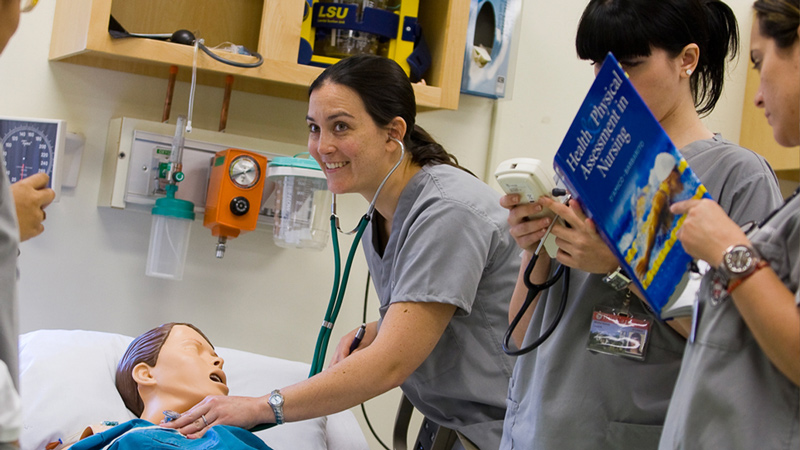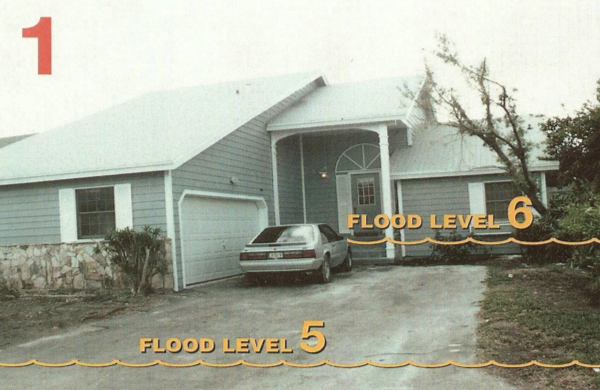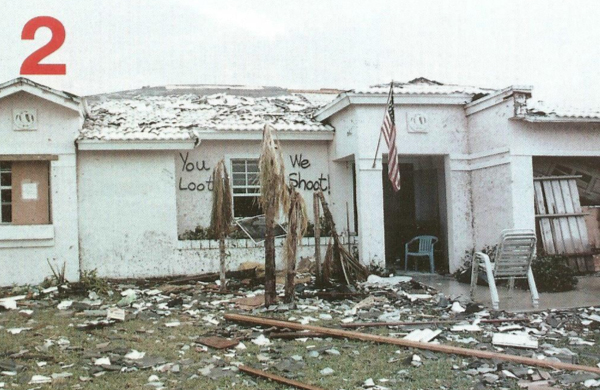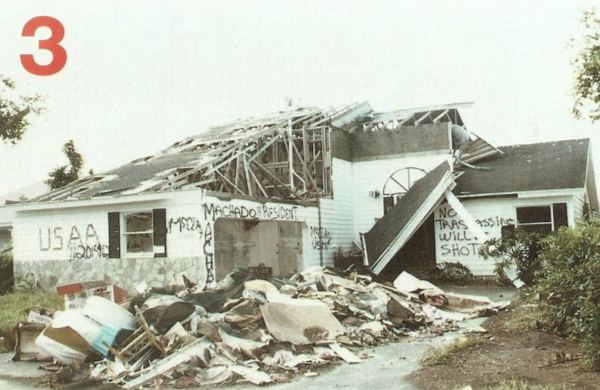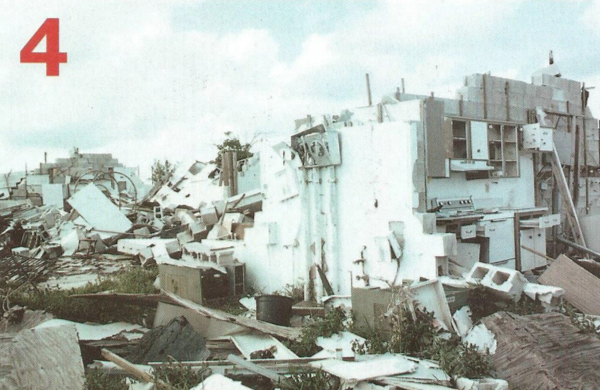- Incident Identification & Threat Assessment
- Emergency Response Levels
- Emergency Notification System
- Emergency Operations Center
- Evacuation
- Temporary Closure
- People with Disabilities
- Public Information Officer
- Designated Areas for Media
- Welfare Status Information
- Maintenance of Critical Services
- Damage Assessment
- Critical Operations Restoration
- Table of Acronyms
- Sample Damage Pictures
- Emergency Support Functions
Response & Recovery Operations
Incident Identification & Threat Assessment
The most critical steps in the emergency response process are incident identification and threat assessment. The University CEMP assumes that most emergency incidents on campus are going to be identified by students, faculty, staff, or visitors. If students, faculty, staff, or visitors are involved in or witness an emergency, it is essential for them to immediately call 911 and the Public Safety Department (x3333 from campus phone, or (305) 899-3333 from cell). This notification is the first step in the activation of the University CEMP and emergency response. The local 911 emergency response agencies and Campus Public Safety will dispatch the appropriate resources to the incident scene. The first responding campus Public Safety Officers are responsible for safely assessing the scene for threats, reporting known threats to other responding officers and confirming the emergency severity and type to the dispatcher. The Department of Public Safety and Emergency Management is then responsible for initiating the emergency notification process as outlined in the section “Alert and Notification” below.
Once the appropriate University personnel are notified of an incident, the threat assessment process begins. University Personnel must assess the emergency incident and any known threats to determine the appropriate level of response. The following sources of information should be used to assist in the threat assessment process:
- Type of incident
- Location of incident
- Time of incident
- Information received from local law enforcement, fire rescue and emergency management agencies
- Information received from Barry University Public Safety personnel on scene
- Information received from local, regional, state, and federal intelligence report
Emergency Response Levels
There are three levels of emergency response. The lower the level of emergency the larger the scale of the incident and the more resources and coordination required to manage it. Any given level may be bypassed if necessary to allow a response to proceed to a higher level. The responsibility of classifying emergency levels starts at the campus level and proceeds to local law enforcement and fire rescue agencies as the severity of the emergency increases.
Level 3 - Minor Emergency
A Minor Emergency is defined as an unplanned incident that is not likely to adversely impact or threaten life, health, safety or property and limited impact on normal University operations. Response to a Minor Emergency is managed at the campus level with limited support from external resources. Control of the incident is within the capabilities of the University employees, equipment and technical skills, and the duration of the incident is determined to be short term. The University CEMP is not activated for a Minor Emergency. However, certain sections of the CEMP can be used as standard operating guidelines to the extent necessary.
The following descriptions and notification procedures address campus emergency situations that DO NOT REQUIRE activation of the University’s Comprehensive Emergency Management Plan.
Criteria
- Incident resolved by University employees with the assistance from Operations, Public Safety Department, and/or Facilities Management, Etc.
- An outside agency may be involved as a precaution as part of existing standard operating procedures (i.e., Security partner, local Law Enforcement Organizations)
- Written reports relative to the incident are filed with the Public Safety Department or appropriate entity at the University (i.e., Facilities Management, Housing and Residence Life)
- No outside medical assistance is required.
- Establishment of a Command post and or operational group is optional.
- After incident report or review of response is optional at the discretion of Incident Commander or other ECA member.
Examples
Automatic fire alarm, sprinkler activation, small chemical spill, localized power outage, localized water pipe break affecting portion of building, localized unidentifiable odor, student demonstration, criminal activity, etc.
Level 2 - Major Emergency
A Major Emergency is defined as an incident that threatens life or safety and/or severely impacts normal University operations. Response to a Major Emergency can be managed at the campus level and could require significant resources that are both internal and external to the University. The University CEMP is activated for a Major Emergency. The Miami-Dade County Office of Emergency Management (305-468-5400) will be notified immediately when a Major Emergency is occurring on the main campus. Emergencies at sites not on the main campus will follow the appropriate county emergency management agency.
Level 1 - Disaster
A disaster is defined as an incident that results in the catastrophic loss of life and or closure of the campus for an extended period of time. Response to a disaster is managed at the University level and requires mutual aid from external agencies. The University CEMP is activated for a disaster and the Miami-Dade County Department of Emergency Services Duty Officer (305-468-5800) will be notified immediately when a disaster is occurring on campus.
Barry University Emergency Notification System
To aid in the awareness of students, faculty, staff, and visitors, The University has interfacing electronic emergency notification systems that include Rave Guardian mobile phone app, Alertus desktop, and a sight/sound mass notification system in place.
Emergency Communication Methods
- SMS Text Message
- Bulk Email
- Public Address (sight/sound)
- Desktop alert
- Barry University Website
- Voice Message
- Media Release / Press Conference Secondary (15 minutes and beyond)
- University Hotline
Decision Criteria
The Five criteria will be considered to determine if activation of the University Emergency Notification System is warranted, which communications delivery methods will be utilized, and who authorizes activation of a system:
- Hazard Type;
- What is the hazard? (Room fire, tornado, or hurricane)
- What is the impact to Barry University? (Minor, major, or disaster)
- What is the potential for the situation to worsen?
- Is the situation under control?
- Life Safety I Property Protection;
- What is the potential for death?
- What is the potential for serious injury?
- What is the potential for minor injury?
- What is the potential for damage?
- What is the potential for disruption to normal course of business?
- Urgency (Timely Notification and Warning);
- How soon does the message need to go out? (Seconds, hours, or days)
- Is there time for approval?
- Audience;
- Who needs to be alerted? (Administration, faculty, staff, students, or visitors)
- How many people need to be alerted? (dozens, hundreds, or thousands)
- Capabilities I Limitations;
- What are the limitations of the system? (audience, delivery time, or mass panic)
- Which system should be used? (Press conference, bulk text message, or public address system)
- How quickly can the messages be sent? (Immediately, minutes, or hours)
Activation Approval For University Emergency Notification System
Only individuals who are trained and authorized may activate the University Emergency Notification System during an emergency. As is practical and without jeopardizing life safety, the Director of Public Safety and Emergency Management is the primary person responsible for activating the campus public address system delivery method during a major emergency. If the Director of Public Safety and Emergency Management is not available or incapable of activating the system then the following hierarchical list of persons would assume the role:
- Public Safety Dispatch Officer On-Duty
- Public Safety Supervisor On-Duty
- Public Information Officer
As practical and without jeopardizing life safety, a particular individual should be consulted prior to the University Emergency Notification System message dissemination. The following list, outlined in hierarchical order, contains individuals to contact if the preceding individual is unavailable:
- President
- Member of Emergency Policy Group
- Incident Commander
- Public Information Officer
Authorized users are permitted to send only Prepared Messages without prior consultation with one of the individuals listed above. Situations or messages that do not fall within the prescribed parameters of a Prepared Message must be approved individually by at least one of the individuals above prior to dissemination.
Prepared Messages
The following emergency scenarios have sample messages that were approved by the appropriate University officials. These prepared messages are eligible for immediate activation by an authorized user only if a University emergency falls within the prescribed parameters listed below.
Dangerous Situation
Definition: Any intentional human-generated hazard, generally of an occurring criminal or imminent, that poses an immediate threat to the health and safety of individuals on campus and requires response from local law enforcement.
Examples: active shooter, suicide bomber, hostage situation, civil unrest, terrorist attack, credible bomb or terrorist threat.
Origin: Public Safety Department or Municipal Police Department.
Urgency: Immediate (seconds)
Threat: Potentially fatal or serious injuries to individuals on campus.
Sample Dangerous Situation Prepared Message for Public Address Delivery Methods:
“Attention! Attention Please!
A Dangerous Situation has been confirmed on campus.
Appropriate personnel are responding.
Seek shelter immediately in a secure location and await further instruction.”
Sample Dangerous Situation Prepared Message for SMS Text Message & Bulk Email Delivery Methods:
BARRY UNIVERSITY! DANGEROUS SITUATION! If on campus, seek secure location and await further instruction. If off campus, avoid area. Go to www.barry.edu for details.
Hazardous Condition
Definition: Any technological situation, generally as the result of an unintentional accident or natural occurrence, occurring or imminent, that poses a threat to the health and safety of individuals on campus.
Examples: gas leak, chemical spill, biological hazard, radiological hazard, or large fire.
Origin: Campus Public Safety, Municipal Police Department, or Miami-Dade County Health Department.
Urgency: Immediate (seconds)
Threat: Potentially fatal or serious injuries to individuals exposed to the hazard.
Weather Emergency
Definition: Any natural weather hazard that immediately threatens life safety
Examples: Tornado Spotted, Flood Warning, Severe Lightning (During Outdoor Events)
Origin: National Weather Service - Miami, NOAA Weather Radios, Emergency Alert System, or local media.
Urgency: Immediate (seconds -5 minutes)
Threat: Potentially fatal or serious injuries to individuals located outdoors on campus.
Emergency Declaration
Declaring a University State of Emergency
The University’s President has the authority to declare a University State of Emergency. This declaration activates the University Emergency Management Team with the authority to implement actions for the protection of life and property warranted by the scope, location, and or magnitude of the emergency. If the University President is unavailable, the Provost may declare a University State of Emergency and activate the University Crisis Management Team.
Once the University’s President and/or Provost and or Incident Commander have been notified of a major emergency incident, they should assess the situation to determine if a University State of Emergency should be declared. The following questions should be asked to assist in assessing the situation:
- Are lives threatened?
- Is there significant property damage?
- Are standard University operations departments able to manage the incident?
- Are specialized emergency services needed? (i.e., Bomb Squad, Urban Search and Rescue, SWAT, or HazMat)
- Are significant outside mutual aid services needed from the City, County or State?
- Are University operations and or events severely impacted?
When a University State of Emergency is declared, the University’s Emergency Management Team is activated and the Miami-Dade County (305-468-4500) or appropriate county Emergency Management Duty Officer is notified of the Emergency.
-
MAJOR EMERGENCY DISASTER
-
CONTACT PUBLIC SAFETY AGENCIES
-
NOTIFY THE DEM DUTY OFFICER ACTIVATE UNIVERSITY EOC CRISIS MANAGEMENT TEAM (CMT)
-
ASSIGN INDIVIDUALS TO INTERFACE WITH GOV. AGENCIES
-
NOTIFY FACULTY/STAFF & STUDENTS
-
NOTIFY PARENTS & OTHERS
-
UPDATE/MONITOR BARRY PLAN
-
NOTIFY NEWS/MEDIA OUTLETS
-
-
-
University Emergency Operations Center
During a declared University emergency, the Incident Commander will identify a specific location for the University’s Crisis Management Team to meet, as well as begin directing response actions and assigning emergency responsibilities. The location where the University Crisis Management Team meets will be designated as the “Emergency Operations Center” The Emergency Operations Center will be positioned outside the present and potentially hazardous zone, but close enough to the incident to maintain command.
The Director of Public Safety and Emergency Management should identify a primary and secondary location on campus that could serve as an Emergency Operations Center during an emergency. These locations will be capable of supporting the needed communication resources to respond to an emergency. Additionally, a third location that is off-campus will also be identified in case the primary and secondary designated locations are unsafe or inaccessible during the emergency.
| BARRY UNIVERSITY EOC STATUS | LOCATION |
|---|---|
| Primary | Garner 247 |
| Secondary | Landon Student Events Room (110) |
| Tertiary | Library, Room 301 |
| Off-Campus | TBD |
CAMPUS EMERGENCY RESPONSE KITS
The University’s Director of Public Safety and Emergency Management is responsible for collaborating with the local emergency response agencies that serve and protect the University. Even though collaboration and communication are the priorities of The University and its partners, every effort is taken to familiarize local emergency response personnel with the campus. The CEMP was developed under the assumption that some responders will be dispatched to a University emergency with limited knowledge about the campus layout. Therefore, Public Safety maintains an emergency response kit to be distributed to the local emergency response agencies during a declared emergency. The kits includes the following items:
- One set of keys to campus buildings,
- One paper copy of campus floor plans,
- twenty paper copies of the campus map, and
- Appropriate ICS Forms
PROTECTIVE ACTIONS
There are three protective actions which are shelter-in-place, evacuation, and temporary closure. These protective actions can immediately be issued, and implemented by University public safety personnel or the University’s Emergency Management Team in response to a spontaneous major emergency.
The cancellation of a The University sponsored event or the closure of the University in preparation for a tropical storm, hurricane or other planned event is not covered below. Closures in preparation for a tropical storm or hurricane are covered in the Hazard Specific section of the CEMP.
SHELTER-IN-PLACE
One of the protective actions that may be issued by authorized personnel, Public Safety or the University’s Crisis Management Team is “shelter-in-place.” A shelter-in-place protective action may be issued in response to a hazardous material which has been spilled or released, an active shooter situation, or weather emergency. This protective action is aimed at keeping students, faculty, staff and visitors safe while remaining indoors. Shelter-in-place allows for a secure, interior room if possible, with no or few windows, and to be used to take refuge. Students, faculty, staff and visitors are required to immediately activate the shelter-in-place protective action in an orderly manner, when directed by emergency response personnel or the University Emergency Notification System message.
Evacuation
One of the protective actions that may be issued by the Public Safety Department or a University Emergency Management Team personnel is a building, or campus-wide evacuation protective action. An evacuative protective action may be issued in response to a fire, hazardous materials spill or release, or an active shooter situation. An evacuative protective action should not be issued for a bomb threat unless there is credible and specific information regarding the location and time of the threat. This protective action is aimed at keeping students, faculty, staff and visitors safe, by creating distance between them and the hazard area. Evacuation means immediately leaving the area in which you are located for another designated safe location. If a campus-wide evacuation is issued, everyone on a campus is required to immediately leave on foot in an orderly manner, and should not try to leave by car. Specific information regarding how to properly evacuate can be accessed on the University’s website at www.barry.edu/prepare, or can be requested at the Public Safety offices located on campus.
Temporary Closure
One of the protective actions that may be issued by the Public Safety Department or University Crisis Management Team personnel is “temporary closure.” A temporary closure protective action may be issued after an evacuation has been ordered, and it is determined that a building or the campus is unsafe until further notice. This protective action is aimed to keep students, faculty, staff and visitors safe by keeping them out of the hazard area, and away from emergency response operations. Additionally, temporary closure means all campus classes and functions are canceled until further notice. Only essential personnel should remain on campus, unless they are ordered to leave by the Public Safety Department, University Emergency Management Team, or local emergency response agency personnel. Current information regarding the status of all the University campuses during an emergency can be accessed at www.barry.edu/prepare.
People with Disabilities
The University recognizes the need to incorporate provisions within all sections of the CEMP to address the specific needs of people with temporary or permanent impairments to their vision, hearing, or mobility. This CEMP addresses the unique issues regarding identifying people with disabilities who might need assistance during an emergency, and make provisions for notification and evacuation. The University’s Crisis Management team ensures that the requirements of students and employees with disabilities will be maintained in all sections of the University CEMP. The University’s Director of Public Safety and Emergency Management will work with the Office of Accessibility Services and Human Resources to ensure that all people with a disability will have access to all information, plans, products, and services developed for emergency preparedness.
Evacuation of Persons With Disabilities
The University has fire stairwells that can be used as primary areas of refuge on all floors of each building, where there are no exits at ground level. Whenever possible, these locations will be in approximately the same place on each floor, and close to a stairwell. These designated locations allow for the swift evacuation of persons with disabilities by emergency personnel, as they do not have to locate a variety of offices or locations throughout the building. These locations should have a closing door, a phone for communication, and supplies that enable the person(s) to block smoke from entering under the door. If possible, they also should have a window so that evacuees can signal their location; however, the fire rating of the location is most important. This location must be clearly indicated on emergency evacuation plans, to ensure that faculty, staff, students, visitors and emergency personnel may easily locate them. The Director of Public Safety and Emergency Management shall consult with the local fire department and University Facilities Management to identify possible primary areas of refuge based on building configuration and construction.
In circumstances where evacuation is not possible, and a primary area of refuge has not been identified, a person with a disability should remain where he or she is and inform at least two other evacuees of their location. This information is to be provided immediately to the Public Safety Department. If a telephone is available to the person with a disability, he or she should call the Public Safety Department to confirm his or her location, and provide details regarding his/her current situation and identify his or her request for accommodation.
The Public Safety Department is required to maintain necessary equipment that may assist with the emergency evacuation of persons with disabilities, especially persons with mobility impairments who cannot use the stairs. This equipment should only be used in life threatening situations since it requires two or more trained personnel, and can easily hurt someone if used incorrectly. Similarly, individuals with mobility impairments should only be carried out of a building in case of a life threatening emergency. This presents a risk not only for the person with a disability, but also the "good Samaritans" or “buddies” who have agreed to assist the individual. Both of types of evacuation require extensive training by emergency evacuation professionals.
Students, faculty, and staff with a disability are encouraged to review the methods of emergency notification that are present on campus. This information is posted on the University Public Safety’s webpage at https://www.barry.edu/en/campus-safety/. The University has installed an Emergency Notification System equipped with sight and sound notification methods that are integrated into the fire alarm system across the Miami Shores campus. The system includes public address, strobe light and marquee alerts so that all persons, including those with hearing and or sight impairments will have access to emergency notification.
Public Information Officer
The Public Information Officer (or his/her official designee) and the University’s President are the only official spokespersons for The University who are authorized to complete interviews with the media during a declared University emergency. The Public Information Officer and the University’s President are authorized to designate other official spokespersons for The University as necessary and or appropriate.
Designated Areas For Media
The University CEMP was developed under the assumption that there will be increased media presence during a campus major emergency. Without coordination and a secure perimeter, the media can interfere with response operations. Therefore, the University has designated assembly area(s) for media near the campus, to prevent interference with response operations. A media assembly area will be positioned outside the present and potential hazard zone and the secure perimeter of response operations, but close enough to accurately report the incident. The Director of Public Safety and Emergency Management will work with the Public Information Officer and Facilities Management personnel to identify a location on campus that could serve as a designated location to assemble the media during a declared emergency. As the scope of the emergency increases, so will the media presence. Therefore, The University will identify locations that are capable of holding a large press conference after the emergency. A designated press conference location should be positioned as close to the Joint Information Center as possible. The Director of Public Safety and Emergency Management will work with the Public Information Officer and the Facilities Management to identify a location that could hold large press conferences after an emergency.
Welfare Status Information
The welfare of students, faculty and staff and family reunification are of primary concern during and after a major life threatening emergency. Requests for information regarding the welfare of students and employees could quickly overwhelm the University's internal communication resources, and negatively impact the University's response capabilities. Increased demand on external communication infrastructure, such as cell phones, will also hinder the family reunification process. Therefore, the University’s Emergency Management Team personnel will immediately evaluate the need to implement an external accountability system for the University community, to report their welfare status. Once the need for student and employee accountability has been determined, the University will request assistance from designated local, regional and state agencies.
Maintenance Of Critical Services
A major emergency may cause the University to cease certain operations. However, in order for the University to effectively respond to a major emergency, continue to protect life and property, and to eventually restore critical operations, certain services must be maintained. The following services must be maintained throughout the incident:
- Public Safety
- Facility Operations
- Facility Safety & Security Systems
- Plant Maintenance
- Computer & Network Services (DoIT)
- Telecommunications (DoIT)
- Purchasing
- Payroll
Damage Assessment
The University’s Physical Plant has adopted the Post Hurricane Building Assessment (sample pictures page 31) and Recovery Process used by Miami-Dade County Division of Emergency Management, to determine the extent of damages after a hurricane and the length of time needed to resume normal on-campus operations. The key in the table below will be used to assess damage from a major emergency or disaster regardless of the cause. This key can be used to assess the damage of buildings and operational resources, as well as the campus as a whole. The damage assessment key includes:
| LEVEL | NAME | DESCRIPTION |
|---|---|---|
| 1 | Minor Damage | the building is habitable with the need for minor repairs and or cleaning |
| 2 | Major Damage Habitable | the building has significant damage, but is still habitable |
| 3 | Major Damage, Uninhabitable | the building has significant damage and is Uninhabitable |
| 6 | Destroyed | the building is destroyed (“pancaked”) and will be demolished |
| 5 | Flood Level 5 | the property around the building is flooded, but no water intrusion to the building |
| 6 | Flood Level 6 | the building has water intrusion |
Critical Operations Restoration
As the immediate threat to life, property, and the environment subsides; the restoration of critical University operations becomes the priority. A major emergency or disaster may cause the entire University to cease critical operations. The restoration of critical operations is the first step of transitioning from emergency response to recovery, once it has been determined that the campus is safe and secure for all personnel. The Planning Chief will be responsible for planning ahead and strategizing about the recovery process, while emergency response actions are still being implemented. The specific processes and responsibilities regarding the restoration of critical University operations are not covered in the University CEMP Basic Plan.
Table Of Acronyms
| ACRONYM | MEANING |
|---|---|
| BU | Barry University |
| CEMP | Comprehensive Emergency Management Plan |
| DHS | U.S. Department of Homeland Security |
| DSOC | Domestic Security Oversight Committee |
| EMT | Emergency Management Team |
| EOC | Emergency Operations Center |
| EOP | Emergency Operations Plan |
| EPG | Emergency Policy Group |
| ESF | Emergency Support Function |
| FDLE | Florida Department of Law Enforcement |
| FDEM | Florida Division of Emergency Management |
| FEMA | Federal Emergency Management Agency |
| FOUO | For Official Use Only |
| HSEEP | Homeland Security Exercise and Evaluation Program |
| ICS | Incident Command System |
| IAP | Incident Action Plan |
| MAC | Multi-Agency Coordination |
| MDCDEM | Miami-Dade County Department of Emergency Management |
| NIMS | National Incident Management System |
| NRF | National Frame Work |
| NRP | National Response Plan |
| PIO | Public Information Officer |
| POC | Point of Contact |
| RDSTF | Regional Domestic Security Task Force |
| SOP | Standard Operating Procedure |
